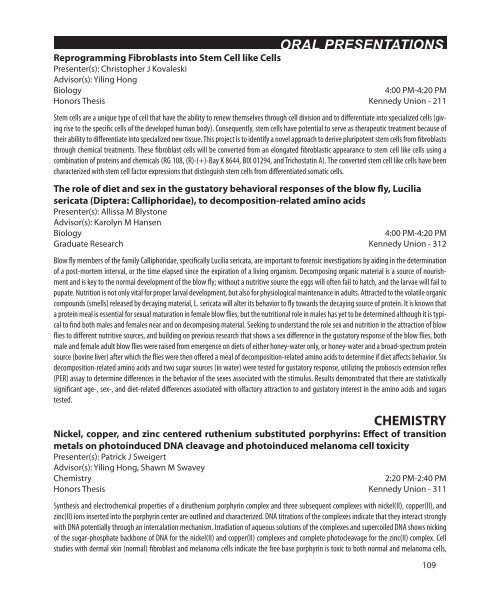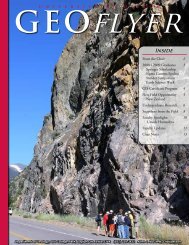Stander Symposium abstract book - University of Dayton
Stander Symposium abstract book - University of Dayton
Stander Symposium abstract book - University of Dayton
You also want an ePaper? Increase the reach of your titles
YUMPU automatically turns print PDFs into web optimized ePapers that Google loves.
ORAL PRESENTATIONS<br />
Reprogramming Fibroblasts into Stem Cell like Cells<br />
Presenter(s): Christopher J Kovaleski<br />
Advisor(s): Yiling Hong<br />
Biology<br />
4:00 PM-4:20 PM<br />
Honors Thesis Kennedy Union - 211<br />
Stem cells are a unique type <strong>of</strong> cell that have the ability to renew themselves through cell division and to differentiate into specialized cells (giving<br />
rise to the specific cells <strong>of</strong> the developed human body). Consequently, stem cells have potential to serve as therapeutic treatment because <strong>of</strong><br />
their ability to differentiate into specialized new tissue. This project is to identify a novel approach to derive pluripotent stem cells from fibroblasts<br />
through chemical treatments. These fibroblast cells will be converted from an elongated fibroblastic appearance to stem cell like cells using a<br />
combination <strong>of</strong> proteins and chemicals (RG 108, (R)-(+)-Bay K 8644, BIX 01294, and Trichostatin A). The converted stem cell like cells have been<br />
characterized with stem cell factor expressions that distinguish stem cells from differentiated somatic cells.<br />
The role <strong>of</strong> diet and sex in the gustatory behavioral responses <strong>of</strong> the blow fly, Lucilia<br />
sericata (Diptera: Calliphoridae), to decomposition-related amino acids<br />
Presenter(s): Allissa M Blystone<br />
Advisor(s): Karolyn M Hansen<br />
Biology<br />
4:00 PM-4:20 PM<br />
Graduate Research Kennedy Union - 312<br />
Blow fly members <strong>of</strong> the family Calliphoridae, specifically Lucilia sericata, are important to forensic investigations by aiding in the determination<br />
<strong>of</strong> a post-mortem interval, or the time elapsed since the expiration <strong>of</strong> a living organism. Decomposing organic material is a source <strong>of</strong> nourishment<br />
and is key to the normal development <strong>of</strong> the blow fly; without a nutritive source the eggs will <strong>of</strong>ten fail to hatch, and the larvae will fail to<br />
pupate. Nutrition is not only vital for proper larval development, but also for physiological maintenance in adults. Attracted to the volatile organic<br />
compounds (smells) released by decaying material, L. sericata will alter its behavior to fly towards the decaying source <strong>of</strong> protein. It is known that<br />
a protein meal is essential for sexual maturation in female blow flies, but the nutritional role in males has yet to be determined although it is typical<br />
to find both males and females near and on decomposing material. Seeking to understand the role sex and nutrition in the attraction <strong>of</strong> blow<br />
flies to different nutritive sources, and building on previous research that shows a sex difference in the gustatory response <strong>of</strong> the blow flies, both<br />
male and female adult blow flies were raised from emergence on diets <strong>of</strong> either honey-water only, or honey-water and a broad-spectrum protein<br />
source (bovine liver) after which the flies were then <strong>of</strong>fered a meal <strong>of</strong> decomposition-related amino acids to determine if diet affects behavior. Six<br />
decomposition-related amino acids and two sugar sources (in water) were tested for gustatory response, utilizing the proboscis extension reflex<br />
(PER) assay to determine differences in the behavior <strong>of</strong> the sexes associated with the stimulus. Results demonstrated that there are statistically<br />
significant age-, sex-, and diet-related differences associated with olfactory attraction to and gustatory interest in the amino acids and sugars<br />
tested.<br />
CHEMISTRY<br />
Nickel, copper, and zinc centered ruthenium substituted porphyrins: Effect <strong>of</strong> transition<br />
metals on photoinduced DNA cleavage and photoinduced melanoma cell toxicity<br />
Presenter(s): Patrick J Sweigert<br />
Advisor(s): Yiling Hong, Shawn M Swavey<br />
Chemistry<br />
2:20 PM-2:40 PM<br />
Honors Thesis Kennedy Union - 311<br />
Synthesis and electrochemical properties <strong>of</strong> a diruthenium porphyrin complex and three subsequent complexes with nickel(II), copper(II), and<br />
zinc(II) ions inserted into the porphyrin center are outlined and characterized. DNA titrations <strong>of</strong> the complexes indicate that they interact strongly<br />
with DNA potentially through an intercalation mechanism. Irradiation <strong>of</strong> aqueous solutions <strong>of</strong> the complexes and supercoiled DNA shows nicking<br />
<strong>of</strong> the sugar-phosphate backbone <strong>of</strong> DNA for the nickel(II) and copper(II) complexes and complete photocleavage for the zinc(II) complex. Cell<br />
studies with dermal skin (normal) fibroblast and melanoma cells indicate the free base porphyrin is toxic to both normal and melanoma cells,<br />
109

















